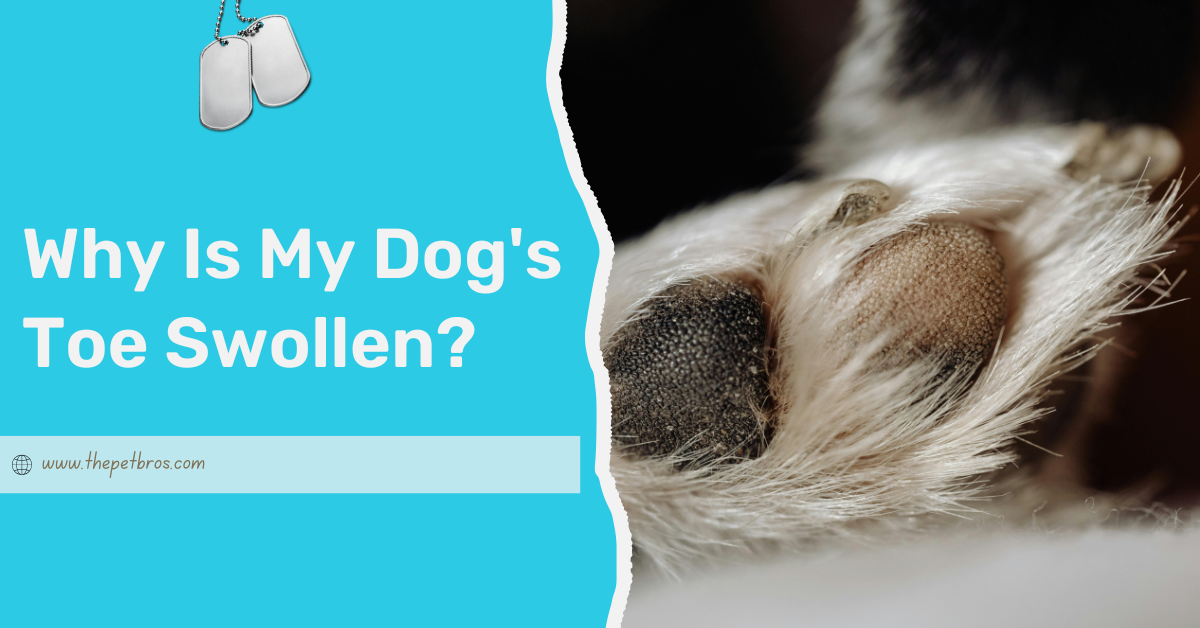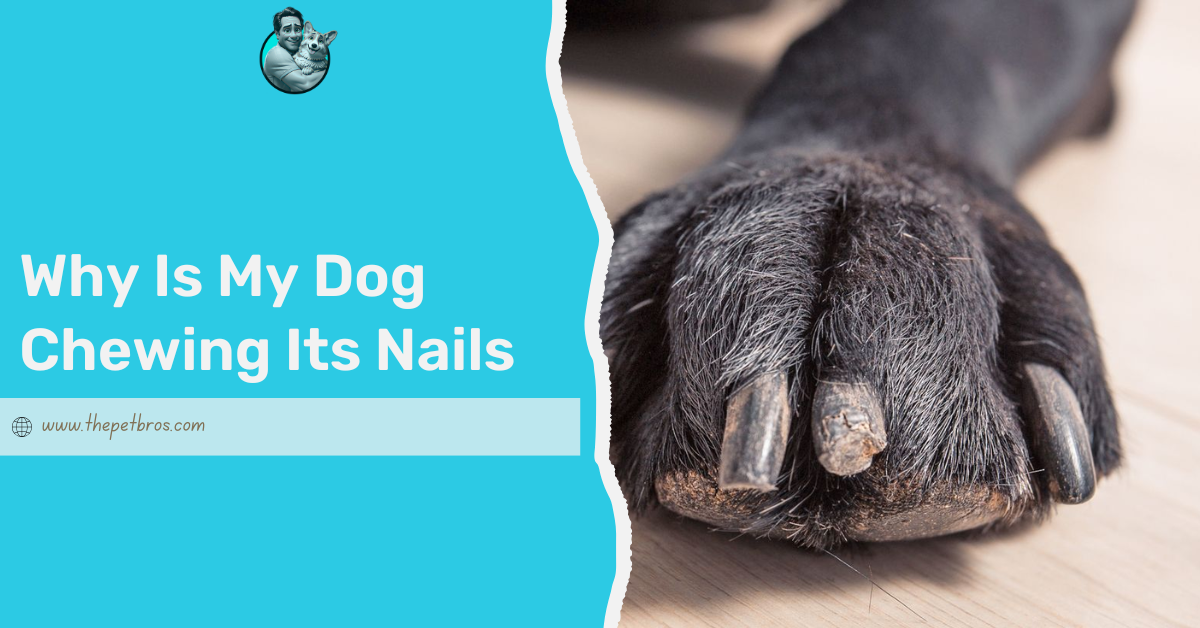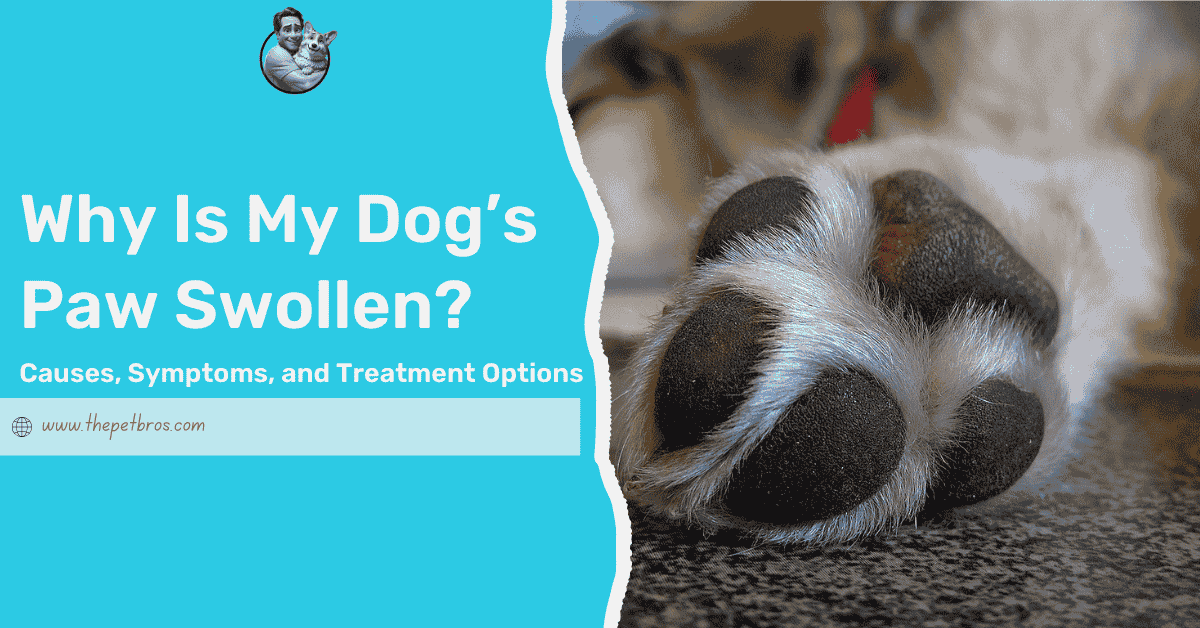Have you ever noticed your dog limping or obsessively licking their paw, only to discover that one of the dog’s toes looks swollen? Of course, a swollen toe might seem like a small issue, but it can signal anything from a minor irritation to a more serious underlying condition.
So, why is your dog’s toe swollen? In this blog post, we’ll examine the common causes of your dog’s swollen toe, explore treatment options, and offer practical prevention tips to keep your pup’s toe in its best shape.
7 Common Causes of Your Dog’s Toe Swollen
The primary reasons why your dog’s toe is swollen are:
- Due to injury or trauma
- Foreign objects
- Infections
- Allergy
- Tumours in the toe
- Nail bed issues
- Arthritis
1. Injury or Trauma
Dogs are naturally energetic and curious, which often leads them into scenarios where minor injuries occur. To put things into context, you may find your dog digging into beds and couches, playing with the garden bed, jumping from the bed onto the floor, and so much more. This is fun for them. However, trauma to the toe can happen during these kinds of plays or even a simple misstep at home. These injuries might include sprains, bruises, or even fractures, depending on the severity of the impact and can cause your dog’s toe to become swollen.
Generally, when your dog’s toe is swollen due to trauma, you will find the dog limping or avoiding putting weight on the affected toe. Swelling is often accompanied by visible redness or bruising, and the toe may feel warm to the touch. In more severe cases, you might notice deformities in the toe, suggesting a possible dislocation or fracture.
For minor injuries, start by limiting your dog’s activity to reduce further strain on the toe. Applying a cold compress can also help minimise swelling. However, while doing this, avoid pressing too hard to prevent discomfort. If the swelling persists for over a day or your dog shows signs of severe pain, consult your vet to rule out fractures or ligament damage. They may recommend X-rays or prescribe anti-inflammatory medication.
2. Foreign Objects (e.g., Thorns or Splinters)
These plays and even outdoor walks can sometimes result in foreign objects, such as thorns, splinters, or small glass shards, getting into your dog’s paw or between their toes. These objects irritate the surrounding tissue, leading to swelling and localised pain. Dogs with a foreign object in their paw often lick or chew persistently at the affected area.
The swelling is usually limited to the affected toe, and you might notice a small puncture wound or the tip of the object protruding from the skin. In some cases, the swelling might spread slightly if the area becomes infected.
If this is the case for your dog, first, first, ensure you can see the object. Once you can, use clean tweezers to gently remove it. Be sure to clean the area with a pet-safe antiseptic to prevent infection. If the object is deeply embedded or your dog resists due to pain, seek veterinary assistance immediately. They may sedate your dog to remove the object safely and prescribe antibiotics if an infection has developed.
3. Infections
Infections are a frequent cause of swelling and can develop from even minor wounds that go unnoticed. A bacterial infection might occur if your dog steps on something sharp, scratches the area, or gets a small cut while exploring.
Fungal infections, such as yeast or ringworm, are also common, particularly in damp environments. Parasites like mites can additionally invade the paws, causing swelling and intense irritation.
Infected toes often appear red and swollen, and there may be discharge, such as pus, from the affected area. In severe cases, you might notice a foul odour emanating from the wound. Systemic symptoms, such as lethargy, loss of appetite, or fever, can occur if the infection spreads.
Clean the wound immediately if the infection appears minor, using warm water and a gentle antiseptic. Monitor your dog closely, as untreated infections can quickly worsen. If swelling and redness persist or if there is any discharge, please consult a veterinarian. They will likely perform a physical examination and may prescribe antibiotics or antifungal medication to address the issue.
4. Allergic Reactions
Dogs, like humans, can develop allergies that result in inflammation and swelling. Allergic reactions in dogs are commonly triggered by environmental factors such as pollen, grass, or certain household cleaning products.
Contact allergies often affect the toes directly, as this is the area that comes into contact with these substances. Though less common, food allergies can also result in swelling as part of a more generalised response.
Your dog’s swollen toe due to an allergic reaction will most likely be accompanied by itching, redness, and excessive licking or chewing at the paw. Your dog might also display other symptoms, such as watery eyes, sneezing, or skin irritation in other areas.
If you suspect an allergic reaction, try to identify and remove the allergen. For example, if the reaction occurs after a walk in a grassy area, wash your dog’s paws with a gentle, hypoallergenic shampoo. Over-the-counter antihistamines may help in mild cases, but always consult your vet before administering any medication. For ongoing allergies, your vet might recommend allergy testing or a hypoallergenic diet.
5. Growths or Tumours
Sometimes, swelling in a dog’s toe can be attributed to growths, such as benign cysts, warts, or tumours. While many of these growths are harmless, others may be malignant and require immediate medical attention. Tumours affecting the toes can sometimes grow rapidly, causing significant discomfort and swelling.
If the swelling feels firm or the affected area seems irregular, this could be a sign of growth. Watch for changes in size, colour, or texture, as well as any signs of pain when the area is touched. If your dog is limping or avoids using the paw entirely, a tumour could be impacting mobility.
Ensure any unexplained growths or swelling is examined by a veterinarian. They may recommend a biopsy or imaging to determine whether the growth is benign or malignant. Early diagnosis is key to effective treatment of your dog’s swollen toe, which might involve surgical removal or other interventions.
6. Nail Bed Issues
The health of your dog’s nails and nail beds can significantly impact the overall condition of their paws. Issues such as ingrown nails, cracked nails, or infections in the nail bed can lead to inflammation and swelling.
These conditions are often painful and may discourage your dog from walking or using the affected toe. Swelling and redness are usually concentrated around the nail. Infections in the nail bed may produce pus or an unpleasant smell. Your dog might lick the area excessively and show signs of pain when the toe is touched.
Keep your dog’s nails trimmed to an appropriate length to prevent ingrown nails. If swelling occurs, clean the area and monitor for signs of infection.
7. Arthritis or Joint-Related Issues
Older dogs are particularly prone to arthritis and joint inflammation, which can affect their toes. Arthritis develops as the cartilage in the joints wears down over time, leading to pain, stiffness, and occasional swelling. Joint-related swelling might also occur in younger dogs with conditions such as autoimmune diseases.
Dogs with arthritis may struggle with mobility, showing stiffness or hesitation to walk, especially after periods of rest or intense activity. Swelling may occur around the joints, including the toes, and the discomfort might worsen in colder weather.
Unfortunately, arthritis cannot be cured. However, its symptoms can be managed. Consult your vet to develop a treatment plan, which might include anti-inflammatory medications, joint supplements, or physical therapy. Maintaining a healthy weight can also reduce stress on your dog’s joints.
What to Do if Your Dog’s Toe Is Swollen
When you notice your dog’s toe is swollen, it’s essential to take prompt and thoughtful action. Swelling can result from various causes, as established in the previous section. Therefore, here’s a step-by-step guide on what to do if your dog’s toe is swollen.
Step 1: Observe and Document the Symptoms
Start by carefully observing your dog’s behaviour and the condition of the swollen toe. Look for any visible signs of injury, redness, bruising, or discharge. Note if your dog is limping, licking the affected area, or avoiding putting weight on the paw. These observations can help you identify possible causes.
Step 2: Clean and Soothe the Affected Area
If the swelling appears to be minor and caused by an injury, foreign object, or irritation, clean the area gently to reduce the risk of infection. Use warm water and a pet-safe antiseptic solution to wash the paw, paying close attention to the swollen toe.
How to Do It:
- Fill a shallow bowl with warm water and a small amount of antiseptic.
- Gently soak your dog’s paw for a few minutes to clean the area.
- Dry the paw thoroughly with a clean towel to prevent dampness, which can encourage fungal growth.
If the swelling seems related to an allergic reaction or irritation, you can try rinsing the paw with a hypoallergenic dog shampoo or a saline solution.
Step 3: Check for Foreign Objects
After cleaning the paw, carefully inspect the swollen toe for any foreign objects, such as thorns, splinters, or glass. Use good lighting and, if necessary, a magnifying glass to examine between the toes and around the nail bed. If the object is visible and easily accessible, use clean tweezers to gently remove it. Also, avoid digging too deeply or causing additional pain. However, if the object is deeply embedded or causes significant bleeding, contact your vet immediately.
Step 4: Apply a Cold Compress
To reduce swelling and provide relief, you can apply a cold compress to the swollen toe. This is particularly effective if the swelling is due to an injury or trauma.
How to Apply:
- Wrap a few ice cubes or a cold gel pack in a clean cloth.
- Hold the compress gently against the swollen toe for 10–15 minutes.
- Repeat this process a few times a day as needed.
Please note: avoid placing ice directly on your dog’s skin, as this can cause frostbite.
Step 5: Monitor Your Dog Closely
Even if the swelling appears minor, it’s important to monitor your dog over the next 24–48 hours. Watch for signs of improvement, such as reduced swelling or a return to normal behaviour. If the swelling worsens or is accompanied by additional symptoms such as discharge, fever, or persistent limping), professional care is essential. Please see a professional vet near you.
Conclusion
A swollen toe in your dog can be worrying, and it’s natural to ask, “Why is my dog’s toe swollen?” Understanding the common causes and knowing how to respond can make all the difference. As repeatedly mentioned, if the swelling doesn’t improve or is accompanied by severe symptoms, don’t hesitate to consult your vet. With a little attention and care, your dog’s paws will remain ready for all their adventures!














